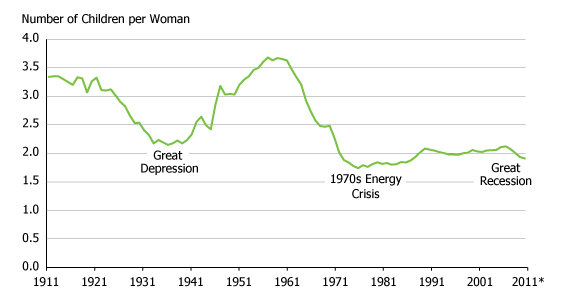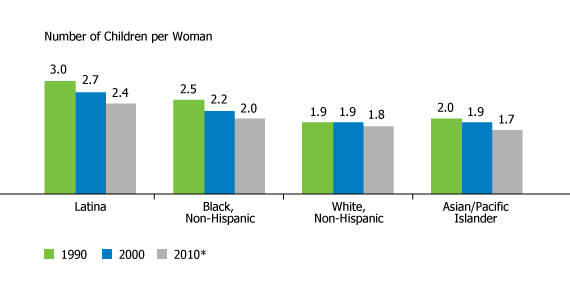What Happened to Marriage and Birth Rates During the Great Depression
In the United states of america and other developed countries, fertility tends to drop during periods of economical pass up. U.S. fertility rates cruel to low levels during the Neat Low (1930s), around the time of the 1970s "oil shock," and since the onset of the recent recession in 2007 (see Effigy 1). The U.S. total fertility rate (TFR) stood at 2.0 births per woman in 2009, but preliminary data from the National Eye for Health Statistics prove that the TFR dropped to 1.ix in 2010—well below the replacement level of 2.1.1 A similar refuse—or leveling off—of fertility rates has been reported in Ireland, Italy, Espana, Sweden, and several other European countries.
Figure i
The U.S. Fertility Charge per unit Has Fallen During Periods of Economic Turn down

* Estimated by PRB.
Source: National Heart for Wellness Statistics
This recent fertility reject may be just a short-term response to high unemployment rates, or it may signal a longer-term drop in lifetime fertility. Most recessions take had relatively small effects on fertility rates—often lasting two to five years. Recessions generally affect the timing of fertility merely non the overall number of children that women will have in their lifetimes.two Longer-term trends in fertility are adamant by broader societal factors, including trends in wedlock; economical development; cultural norms; and women'south education, employment, and access to contraception. Although fertility rates bottomed out during the Great Depression, the birth rate had been declining throughout the 1920s—a period of rapid economic growth—every bit more than couples used birth command to limit family size.3
The U.S. fertility rate is edging closer to TFRs in Europe, where many countries are grappling with very low birth rates (averaging one.vi children per adult female) and potential labor shortages.
Fertility Rates Converge for Different Racial/Ethnic Groups
Fertility rates in the United States take fallen since 1990 among all major racial/ethnic groups (see Figure ii). The Latina fertility rate dropped sharply in recent decades, from 3.0 births per woman in 1990 to 2.4 births per adult female in 2010; and for blackness women from 2.5 to 2.0. Fertility rates amidst white and Asian women have also dropped, but at a slower step, resulting in like fertility rates among different racial and indigenous groups.
Effigy 2
Fertility Rates for Latinas and Blackness Women Are Approaching Those of White and Asian Women.

* Preliminary data.
Source: National Center for Health Statistics.
Relatively high unemployment rates amongst African Americans and Latinos may have played a role in the recent fertility refuse—especially amongst those with less education and lower incomes.4 Simply increasing college attendance, especially among women, is another potential cistron. Education affects the timing of marriages and outset births, typically delaying both. Thus, the U.South. fertility charge per unit may drop further if the share of women attention and completing college continues to increase. Amid 18-to-24-year-olds, more women than men are enrolled in college in every racial and ethnic group.5
A prolonged decline in African American and Latina fertility rates volition bear upon the hereafter racial and ethnic limerick of the United States. The Census Bureau recently reported that over half of all U.Due south. infants are racial/indigenous minorities.vi The U.Southward. population is currently projected to reach "bulk-minority" condition (the point at which less than half of the population is non-Hispanic white) in 2042. For several decades, clearing has been the driving force behind rapid racial/ethnic change in the United States, but a sustained drop in fertility rates could irksome the footstep of growth of the country's minority population.
Young Adults in U.Due south. Postpone Childbirth
The pass up in U.S. fertility has been driven primarily by a trend amongst young adults to postpone having children. Forty years agone, birth rates among women in their 20s were significantly college than those of women in their 30s. In 1970, there were 168 births per i,000 women ages twenty to 24, compared with 73 births per 1,000 women ages 30 to 34. However, this gap has steadily narrowed over fourth dimension. By 2009—for the start time in U.S. history—nascency rates among women ages 30 to 34 (97.5 births per i,000 women) exceeded those for women ages 20 to 24 (96 births per i,000 women). In 2010, the birth rate amid teens dropped to 34 births per 1,000 girls ages xv to 19—the everyman level ever recorded in the United States.
This recent drib in births amid young adults could be linked to the recession. In Europe, high rates of unemployment and depression levels of economic security are strongly associated with declines in fertility among young adults.7 The economic downturn may have had a like effect on young adults' fertility in the United States.
Nevertheless, longer-term fertility trends may depend on future trends in women'due south employment and earnings relative to men.8 Women outnumber men in higher and brand up a growing share of the labor strength. The recession striking male person-dominated jobs the hardest, contributing to a growing share of women who now outearn their husbands.ix As more than women become primary breadwinners, fertility decisions are more likely to swivel on women'south earnings than they did in previous decades. A growing reliance on women'south employment and earnings could further dampen U.S. fertility rates in the coming decades.
References
- The full fertility charge per unit estimates the number of births a woman is expected to have during her lifetime based on current age-specific fertility rates. Replacement level fertility is the level of fertility at which a couple has only enough children to supervene upon themselves, or virtually ii.ane children per couple.
- Tomáš Sobotka, Vegard Skirbekk, and Dimiter Philipov, "Economical Recession and Fertility in the Adult Globe," Population and Development Review 37, no. 2 (2011).
- U.Due south. Centers for Disease Control and Prevention, "Achievements in Public Health, 1900-1999: Family Planning," accessed on June 26, 2012.
- Gretchen Livingston, "In a Down Economy, Fewer Births," accessed on June seven, 2012.
- Linda A. Jacobsen and Mark Mather, "A Mail-Recession Update on U.S. Social and Economical Trends," Population Bulletin Update (December 2011).
- U.Due south. Demography Bureau, "Nearly Children Younger Than Age i Are Minorities," accessed on June 7, 2012.
- Wolfgang Lutz, Vegard Skirbekk, and Maria Rita Testa, "The Depression Fertility Trap Hypothesis," in Vienna Yearbook of Population Research, ed. Dimiter Philipov, Aart Liefbroer, and Francesco Billari (Vienna: Vienna Plant of Demography, 2006); Lisa Bell et al., "Failure to Launch: Cross-National Trends in the Transition to Economic Independence," Luxembourg Income Written report Working Paper Series 456; and Christian Schmitt, "Gender-Specific Effects of Unemployment on Family Formation: A Cantankerous-National Perspective," SOEP 127 (2008).
- Diane J. Macunovich, "Using Economics to Explain U.S. Fertility Trends," in "What Drives U.S. Population Growth?" Mary M. Kent and Mark Mather, Population Bulletin 57, no. 4 (2002).
- Richard Fry and D'Vera Cohn, "New Economic science of Matrimony: The Rise of Wives," accessed on June 7, 2012.
hardwickeandifter.blogspot.com
Source: https://www.prb.org/resources/the-decline-in-u-s-fertility/
0 Response to "What Happened to Marriage and Birth Rates During the Great Depression"
Post a Comment